Yamaha RAPTOR 250 Manual

READ THIS MANUAL CAREFULLY!
It contains important safety information.
OWNER’S MANUAL
YFM25RX
WARNING |
This ATV should not be ridden by anyone under 16 years of age. |
LIT-11626-21-22 |
4D3-28199-10 |
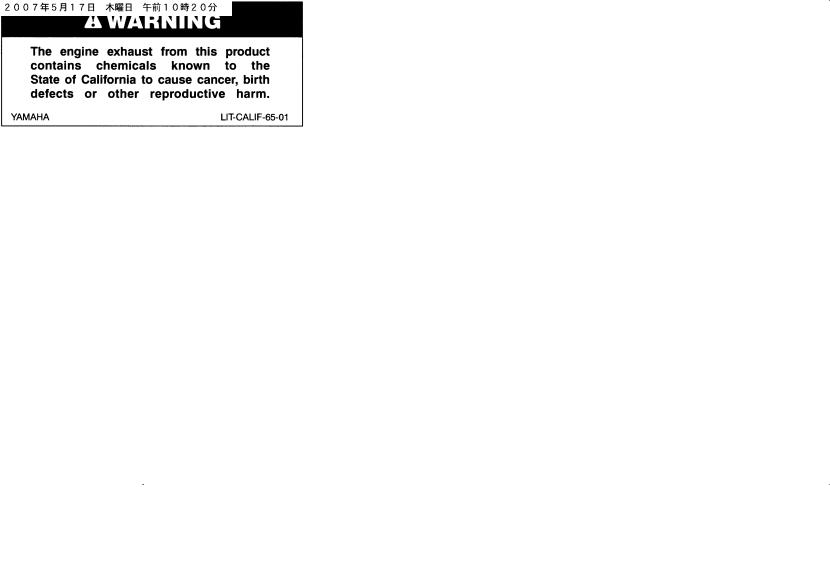
EBU17091

EBU17170
INTRODUCTION
EBU17300
Congratulations on your purchase of the Yamaha YFM25RX. This ATV represents the result of many years of Yamaha experience in the production of fine sporting, touring, and pacesetting racing machines. With the purchase of this Yamaha, you can now appreciate the high degree of craftsmanship and reliability that have made Yamaha a leader in these fields.
This manual will provide you with a good basic understanding of the features and operation of this ATV.
This manual includes important safety information. It provides information about special techniques and skills necessary to ride the ATV. It also includes basic maintenance and inspection procedures. If you have any questions regarding the operation or maintenance of your ATV, please consult a Yamaha dealer.
AN IMPORTANT SAFETY MESSAGE:
●READ THIS MANUAL TOGETHER WITH TIPS FOR THE ATV RIDER CAREFULLY AND COMPLETELY BEFORE OPERATING YOUR ATV. MAKE SURE YOU UNDERSTAND ALL INSTRUCTIONS.
●PAY CLOSE ATTENTION TO THE WARNING AND CAUTION LABELS ON THE ATV.
●NEVER OPERATE AN ATV WITHOUT PROPER TRAINING OR INSTRUCTION. FREE TRAINING IS AVAILABLE TO ANYONE WHO BUYS A NEW ATV. CALL 1-800-887-2887 FOR MORE INFORMATION.
●THIS ATV, AND ANY OTHER ATV OVER 90 cc, SHOULD NOT BE RIDDEN BY ANYONE UNDER 16 YEARS OF AGE.
●THIS ATV IS A HIGH-PERFORMANCE ATV FOR OFF-ROAD USE ONLY, FOR SPORT-TYPE RECREATIONAL AND COMPETITIVE USE BY EXPERIENCED OPERATORS.

EBU17330
IMPORTANT MANUAL INFORMATION
EBU17341
FAILURE TO FOLLOW THE WARNINGS CONTAINED IN THIS MANUAL CAN RESULT IN SERIOUS INJURY OR DEATH.
Particularly important information is distinguished in this manual by the following notations:
The Safety Alert Symbol means ATTENTION! BECOME ALERT! YOUR
SAFETY IS INVOLVED!
Failure to follow WARNING instructions could result in severe injury  WARNING or death to the ATV operator, a bystander, or a person inspecting or
WARNING or death to the ATV operator, a bystander, or a person inspecting or
repairing the ATV.
CAUTION:
A CAUTION indicates special precautions that must be taken to avoid damage to the ATV.
|
|
|
|
|
NOTE: |
|
A NOTE provides key information to make procedures easier or clearer. |
|
|
|
|
|
|
|
|
* Product and specifications are subject to change without notice.

EBU17350
IMPORTANT NOTICE
EBU17360
Welcome to the Yamaha world of motor sports!
This ATV is designed and manufactured for OFF-ROAD use only. It is illegal and unsafe to operate this ATV on any public street, road or highway.
This ATV complies with all applicable OFF-ROAD noise level and spark arrester laws and regulations in effect at the time of manufacture.
Please check your local riding laws and regulations before operating this ATV.
EBU17381 |
|
|
YFM25RX |
||
|
|
|
|
|
|
|
|
|
|
|
OWNER’S MANUAL |
|
|
|
|
|
©2007 by Yamaha Motor Corporation, U.S.A. |
|
|
|
|
||
|
|
|
|
|
1st edition, May 2007 |
|
|
AFFIX DEALER |
|
|
All rights reserved. |
|
|
||||
|
|
|
|
|
Any reprinting or unauthorized use |
|
|
LABEL HERE |
|
|
without the written permission of |
|
|
|
|
Yamaha Motor Corporation, U.S.A. |
|
|
|
|
|
|
|
|
|
|
|
|
is expressly prohibited. |
|
|
|
|
|
Printed in Japan. |
|
|
|
|
||
|
|
|
|
|
P/N LIT-11626-21-22 |
|
|
|
|
|
|
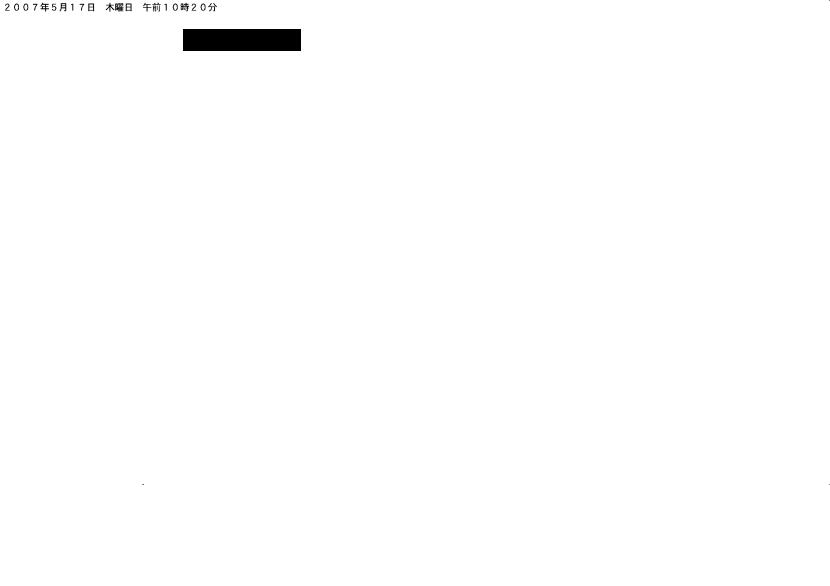
EWB00010
 WARNING
WARNING
Indicates a potential hazard that could result in serious injury or death.
EBU17420
TABLE OF CONTENTS
SAFETY INFORMATION .............................. |
1-1 |
LOCATION OF THE WARNING AND |
|
SPECIFICATION LABELS ............................ |
2-1 |
DESCRIPTION .............................................. |
3-1 |
Left view ..................................................... |
3-1 |
Right view................................................... |
3-1 |
Controls and instruments ........................... |
3-2 |
INSTRUMENT AND CONTROL |
|
FUNCTIONS .................................................. |
4-1 |
Main switch ............................................... |
4-1 |
Indicator light ............................................. |
4-2 |
Handlebar switches ................................... |
4-2 |
Throttle lever ............................................. |
4-3 |
Speed limiter ............................................. |
4-4 |
Clutch lever ................................................ |
4-5 |
Brake lever ................................................. |
4-5 |
Brake pedal ................................................ |
4-6 |
Parking brake lever .................................... |
4-6 |
Shift pedal .................................................. |
4-7 |
Fuel tank cap ............................................. |
4-8 |
Fuel ............................................................ |
4-8 |
Fuel cock ................................................. |
4-10 |
Starter (choke) ......................................... |
4-11 |
Seat ......................................................... |
4-12 |
Adjusting the front shock absorber |
|
assemblies ............................................. |
4-13 |
PRE-OPERATION CHECKS .......................... |
5-1 |
Pre-operation check list ............................. |
5-1 |
Fuel ............................................................ |
5-4 |
Engine oil ................................................... |
5-4 |
Front and rear brakes ................................ |
5-4 |
Throttle lever .............................................. |
5-5 |
Drive chain ................................................. |
5-5 |
Tires ........................................................... |
5-7 |
Measuring the tire pressure ....................... |
5-8 |
Tire wear limit ............................................ |
5-9 |
Chassis fasteners ...................................... |
5-9 |
Instruments, lights and switches ................ |
5-9 |
OPERATION................................................... |
6-1 |
Starting a cold engine ................................ |
6-1 |
Starting a warm engine .............................. |
6-3 |

Shifting ...................................................... |
6-3 |
Engine break-in ......................................... |
6-5 |
Parking ...................................................... |
6-6 |
Parking on a slope .................................... |
6-6 |
Accessories and loading ........................... |
6-7 |
RIDING YOUR ATV ...................................... |
7-1 |
GETTING TO KNOW YOUR ATV.............. |
7-2 |
RIDE WITH CARE AND GOOD |
|
JUDGEMENT........................................... |
7-2 |
BE CAREFUL WHERE YOU RIDE.......... |
7-12 |
TURNING YOUR ATV ............................. |
7-17 |
CLIMBING UPHILL .................................. |
7-19 |
RIDING DOWNHILL................................. |
7-22 |
CROSSING A SLOPE.............................. |
7-24 |
CROSSING THROUGH SHALLOW |
|
WATER .................................................. |
7-25 |
RIDING OVER ROUGH TERRAIN .......... |
7-27 |
SLIDING AND SKIDDING........................ |
7-28 |
WHAT TO DO IF... ................................... |
7-29 |
WHAT TO DO... ....................................... |
7-29 |
PERIODIC MAINTENANCE AND MINOR |
|
REPAIR.......................................................... |
8-1 |
Owner’s manual and tool kit ...................... |
8-1 |
Periodic maintenance chart for the |
|
emission control system .......................... |
8-3 |
General maintenance and lubrication |
|
chart ........................................................ |
8-5 |
Checking the spark plug ............................ |
8-9 |
Engine oil and oil filter element ................ |
8-11 |
Cleaning the air filter element .................. |
8-15 |
Cleaning the spark arrester ..................... |
8-19 |
Adjusting the carburetor ........................... |
8-20 |
Adjusting the engine idling speed ............ |
8-21 |
Adjusting the throttle cable free play ........ |
8-22 |
Valve clearance ....................................... |
8-22 |
Checking the front and rear brake |
|
pads ....................................................... |
8-23 |
Checking the brake fluid level .................. |
8-24 |
Changing the brake fluid .......................... |
8-26 |
Checking the front brake lever free |
|
play ........................................................ |
8-27 |
Checking the brake pedal position ........... |
8-27 |
Adjusting the parking brake free play ...... |
8-28 |
Brake light switches ................................. |
8-30 |
Adjusting the clutch lever free play .......... |
8-31 |
Drive chain slack ...................................... |
8-32 |
Lubricating the drive chain ....................... |
8-33 |
Checking and lubricating the cables ........ |
8-34 |
Checking and lubricating the brake and |
|
clutch levers ........................................... |
8-35 |
Checking and lubricating the brake and |
|
shift pedals ............................................. |
8-36 |
Checking the wheel hub bearings ............ |
8-36 |
Lubricating the swingarm pivots .............. |
8-36 |
Lubricating the upper and lower arm |
|
pivots ..................................................... |
8-37 |

Lubricating the steering shaft .................. |
8-38 |
Battery ..................................................... |
8-38 |
Replacing the fuse .................................. |
8-40 |
Replacing a headlight bulb ...................... |
8-42 |
Adjusting a headlight beam ..................... |
8-44 |
Replacing the tail/brake light bulb ........... |
8-44 |
Removing a wheel ................................... |
8-44 |
Installing a wheel ..................................... |
8-45 |
Troubleshooting ...................................... |
8-45 |
Troubleshooting chart ............................. |
8-47 |
CLEANING AND STORAGE.......................... |
9-1 |
Cleaning .................................................... |
9-1 |
Storage ...................................................... |
9-2 |
SPECIFICATIONS ...................................... |
10-1 |
CONSUMER INFORMATION ...................... |
11-1 |
Identification numbers ............................. |
11-1 |
Noise regulation ...................................... |
11-3 |
Maintenance record ................................ |
11-4 |
YAMAHA MOTOR CORPORATION, |
|
U.S.A. ATV LIMITED WARRANTY ....... |
11-5 |
YAMAHA EXTENDED SERVICE |
|
(Y.E.S.) .................................................. |
11-7 |
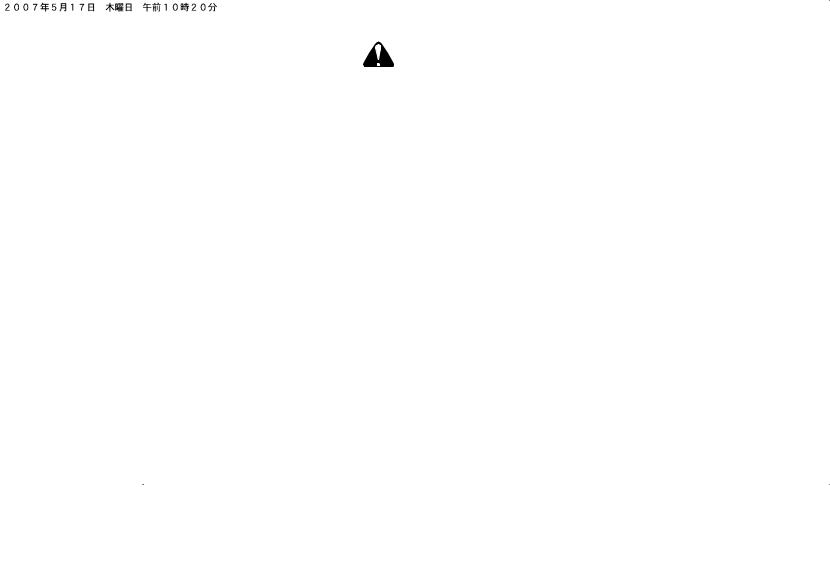
EBU17430
SAFETY INFORMATION |
|
|
|
1 |
|
|
|
|
EBU17572
AN ATV IS NOT A TOY AND CAN BE HAZARDOUS TO OPERATE.
An ATV handles differently from other vehicles, including motorcycles and cars. A collision or rollover can occur quickly, even during routine maneuvers such as turning and riding on hills or over obstacles, if you fail to take proper precautions.
SEVERE INJURY OR DEATH can result if you do not follow these instructions:
●Read this manual and all labels carefully and follow the operating procedures described.
●Never operate an ATV without proper training or instruction. Take a Training Course. Beginners should receive training from a certified instructor. Contact an authorized ATV dealer or call 1- 800-887-2887 to find out about the training courses nearest you.
●Always follow the age recommendation:
– A child under 16 years old should never oper-
1-1
ate an ATV with engine size greater than 90 cc.
●Never allow a child under age 16 to operate an ATV without adult supervision, and never allow continued use of an ATV by a child if he or she does not have the abilities to operate it safely.
●Never carry a passenger on an ATV.
●Always avoid operating an ATV on any paved surfaces, including sidewalks, driveways, parking lots and streets.
●Never operate an ATV on any public street, road or highway, even a dirt or gravel one.
●Never operate an ATV without wearing an approved motorcycle helmet that fits properly. You should also wear eye protection (goggles or face shield), gloves, boots, a long-sleeved shirt or a jacket, and long pants.
●Never consume alcohol or drugs before or while operating this ATV.
●Never operate at speeds too fast for your skills or the riding conditions. Always go at a speed that is proper for the terrain, visibility, operating conditions, and your experience.

●Never attempt wheelies, jumps, or other stunts.
●Always inspect your ATV each time you use it to
1make sure it is in safe operating condition. Always follow the inspection and maintenance procedures and schedules described in this manual.
●Always keep both hands on the handlebars and both feet on the footpegs of the ATV during operation.
●Always go slowly and be extra careful when operating on unfamiliar terrain. Always be alert to changing terrain conditions when operating the ATV.
●Never operate on excessively rough, slippery or loose terrain until you have learned and practiced the skills necessary to control the ATV on such terrain. Always be especially cautious on these kinds of terrain.
●Always follow proper procedures for turning as described in this manual. Practice turning at low speeds before attempting to turn at faster speeds and never turn at excessive speeds.
●Never operate the ATV on hills too steep for the ATV or for your abilities. Practice on smaller hills before attempting larger hills.
●Always follow proper procedures for climbing
hills as described in this manual. Check the terrain carefully before you start up any hill. Never climb hills with excessively slippery or loose surfaces. Shift your weight forward. Never open the throttle suddenly or make sudden gear changes. Never go over the top of a hill at high speed.
●Always follow proper procedures for going down hills and for braking on hills as described in this manual. Check the terrain carefully before you start down any hill. Shift your weight backward. Never go down a hill at high speed. Avoid going down a hill at an angle that would cause the vehicle to lean sharply to one side. Go straight down the hill where possible.
●Always follow proper procedures for crossing the side of a hill as described in this manual. Avoid hills with excessively slippery or loose surfaces. Shift your weight to the uphill side of the ATV. Never attempt to turn the ATV around on any hill until you have mastered the turning technique described in this manual on level ground. Avoid crossing the side of a steep hill if possible.
●Always use proper procedures if you stall or roll backwards when climbing a hill. To avoid stalling, use the proper gear and maintain a steady speed when climbing a hill. If you stall or roll
1-2

backwards, follow the special procedure for braking described in this manual. Dismount on the uphill side or to a side if pointed straight uphill. Turn the ATV around and remount, following the procedure described in this manual.
●Always check for obstacles before operating in a new area.
●Never attempt to operate over large obstacles, such as large rocks or fallen trees. Always follow proper procedures when operating over obstacles as described in this manual.
●Always be careful when skidding or sliding. Learn to safely control skidding or sliding by practicing at low speeds and on level, smooth terrain. On extremely slippery surfaces, such as ice, go slowly and be very cautious in order to reduce the chance of skidding or sliding out of control.
●Never operate an ATV in fast flowing water or in water deeper than that recommended in this manual. Remember that wet brakes may have reduced stopping ability. Test your brakes after leaving water. If necessary, apply them several times to let friction dry out the linings.
●Always use the size and type of tires specified in this manual.
●Always maintain proper tire pressure as described in this manual.
● Never modify an ATV through improper installa- 1 tion or use of accessories.
●Never exceed the stated load capacity for an ATV. Cargo should be properly distributed and securely attached. Reduce speed and follow instructions in this manual for carrying cargo or pulling a trailer. Allow greater distance for braking.
FOR MORE INFORMATION ABOUT ATV SAFETY, call the Consumer Products Safety Commission at 1-800-638-2772, or the ATV Distributor’s Safety Hotline at 1-800-852-5344.
1-3
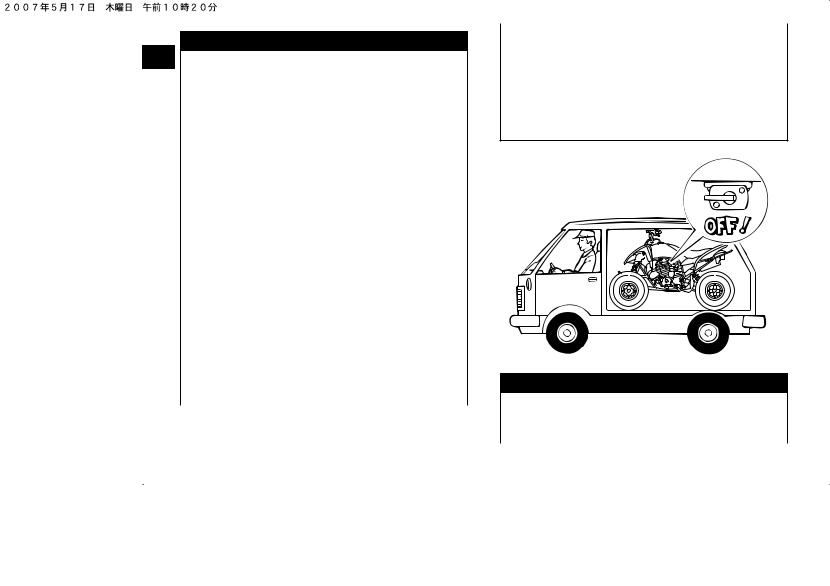
EWB00021
 WARNING
WARNING
1POTENTIAL HAZARD Improper handling of gasoline. WHAT CAN HAPPEN
Gasoline can catch fire and you could be burned.
HOW TO AVOID THE HAZARD
Always turn off the engine when refueling. Do not refuel right after the engine has been running and is still very hot.
Do not spill gasoline on the engine or exhaust pipe/muffler when refueling.
Never refuel while smoking, or in the vicinity of sparks, open flames, or other sources of ignition such as the pilot lights of water heaters and clothes dryers.
When transporting the ATV in another vehicle, be sure it is kept upright and that the fuel cock is in the “OFF” position. Otherwise, fuel may leak out of the carburetor or fuel tank.
WHAT CAN HAPPEN
Gasoline is poisonous and can cause injuries.
HOW TO AVOID THE HAZARD
If you should swallow some gasoline or inhale a lot of gasoline vapor, or get some gasoline in your eyes, seek medical help immediately. If gasoline spills on your skin, wash with soap and water. If gasoline spills on your clothing, change your clothes.
EWB00030 |
 WARNING
WARNING
POTENTIAL HAZARD
Starting or running the engine in a closed area.
1-4

WHAT CAN HAPPEN |
|
|
|
Exhaust fumes are poisonous and may |
|
|
|
1 |
|||
cause loss of consciousness and death with- |
|
||
|
|
||
in a short time. |
|
|
|
HOW TO AVOID THE HAZARD |
|
|
|
Always operate your ATV in an area with ad- |
|
|
|
equate ventilation. |
|
|
|
|
|
|
1-5
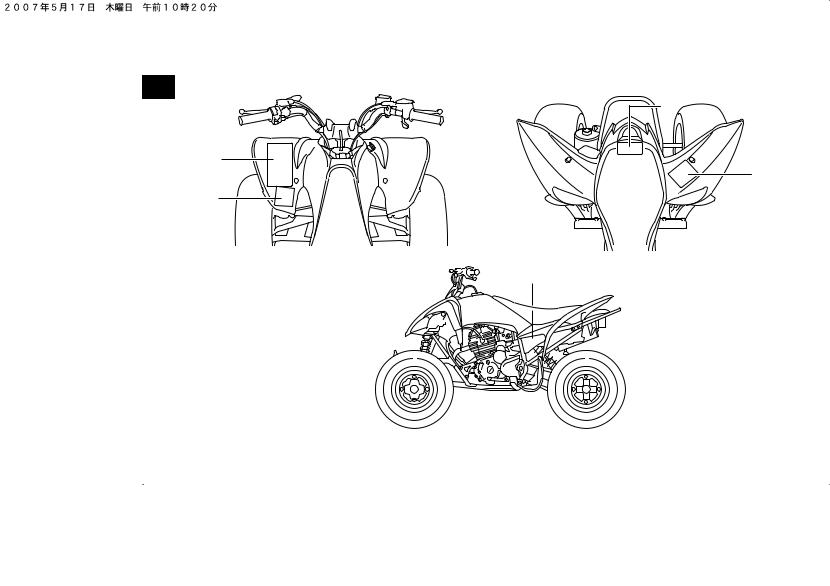
EBU17660
LOCATION OF THE WARNING AND SPECIFICATION LABELS
2
3
2
4
1
5
2-1

EBU17670
Read and understand all of the labels on your ATV. These labels contain important information for safe and proper operation.
Never remove any labels from your ATV. If a label becomes difficult to read or comes off, request a replace- 2 ment label from your Yamaha dealer.
2-2
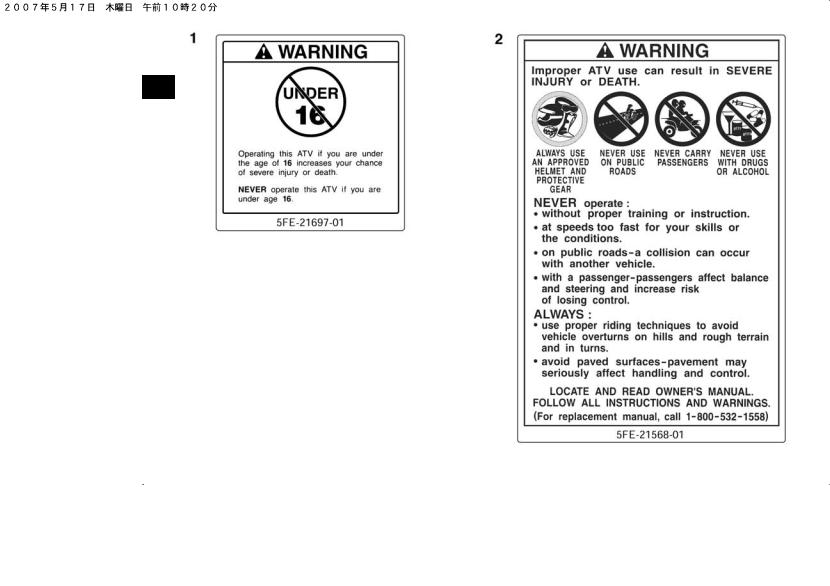
2
2-3

NEVER
2
2-4

EBU17680
|
|
|
|
DESCRIPTION |
|
|
|
EBU17690 |
|
|
|
|
EBU17700 |
|
|
Left view |
|
|
|
|
Right view |
|
|
1 |
2 |
3 4 |
5 |
6 |
1 |
2 |
3 |
3 |
|
|
|
|
|
|
|
|
7 |
|
5 4 |
1. |
Headlights |
1. |
Spark arrester |
2. |
Fuel cock |
2. |
Seat |
3. |
Starter (choke) |
3. |
Fuel tank cap |
4. |
Throttle stop screw |
4. |
Oil filter element |
5. |
Fuse |
5. |
Brake pedal |
6.Tail/brake light
7.Shift pedal
3-1
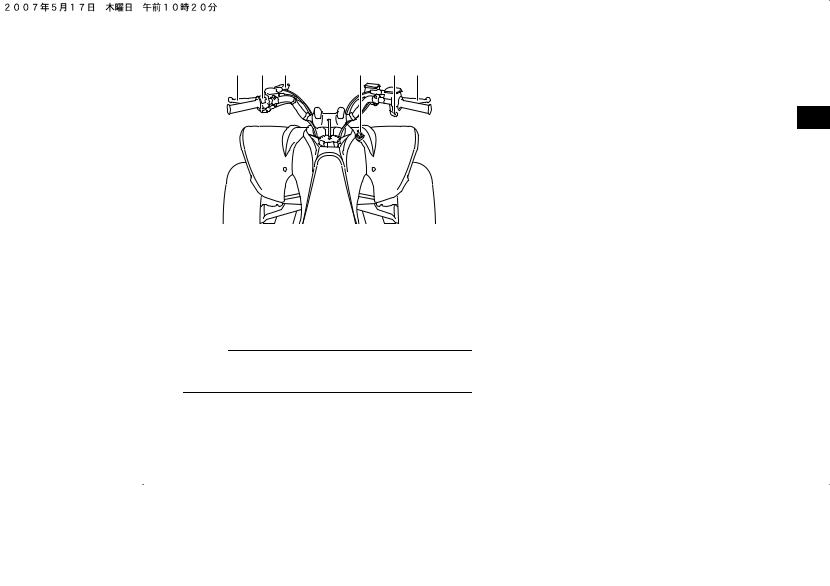
EBU17712
Controls and instruments
1 |
2 |
3 |
4 |
5 |
6 |
3
1.Clutch lever
2.Handlebar switches
3.Parking brake lever
4.Main switch
5.Throttle lever
6.Brake lever
NOTE:
The ATV you have purchased may differ slightly from the figures shown in this manual.
3-2
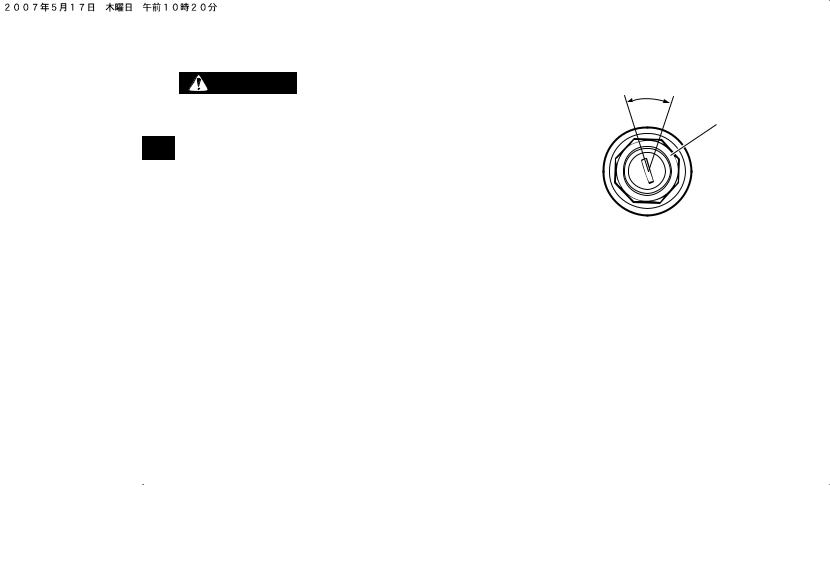
EBU17720
INSTRUMENT AND CONTROL FUNCTIONS
EWB00010
WARNING
OFF ON
Indicates a potential hazard that could result in |
|
serious injury or death. |
1 |
4 EBU17740
Main switch
The positions of the main switch are as follows:
ON
All electrical systems are supplied with power, and the engine can be started. The key cannot be removed.
OFF
All electrical systems are off. The key can be removed.
1. Main switch
4-1
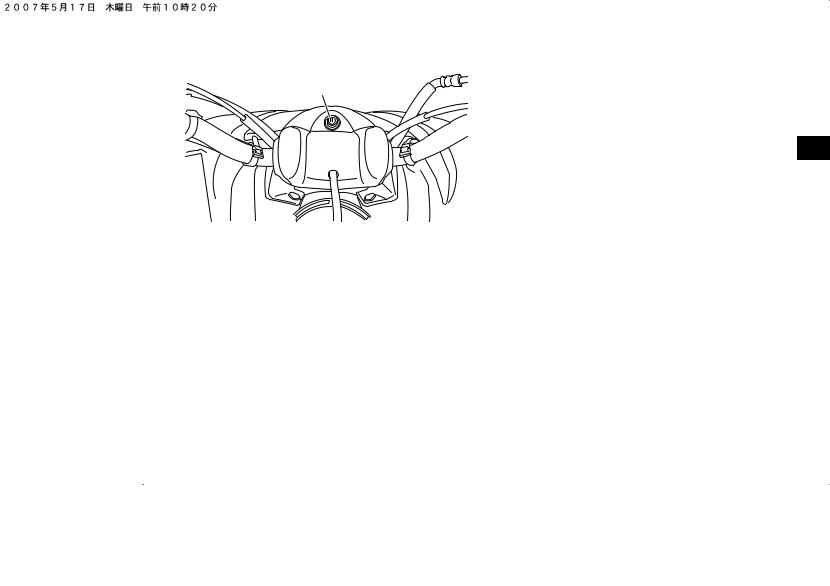
EBU17781
Indicator light
1
1. Neutral indicator light “N”
EBU17860
Neutral indicator light “ ”
”
This indicator light comes on when the transmission is in the neutral position.
EBU18061
Handlebar switches
1
4
2
3
1.Light switch “LIGHTS”
2.Engine stop switch “ENG. STOP”
3.Start switch “START”
EBU18070
Engine stop switch “ENG. STOP”
Set this switch to “RUN” before starting the engine. The engine stop switch controls the ignition and stops the engine when it is running. Use this switch to stop the engine in an emergency situation. The engine will not start or run when this switch is set to “OFF”.
4-2
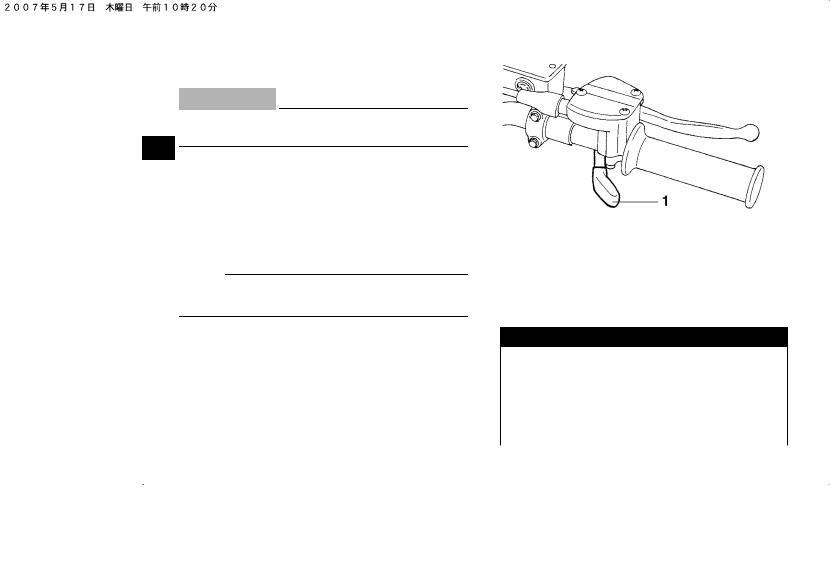
EBU18090
Start switch “START”
Push this switch to crank the engine with the starter.
ECB00050
CAUTION:
See the starting instructions on page 6-1 prior
to starting the engine.
4
EBU18120
Light switch “LIGHTS”
Set this switch to “LO” to turn on the low beams and the taillight. Set the switch to “HI” to turn on the high beams and the taillight. Set the switch to “OFF” to turn off all the lights.
NOTE:
The headlights and the taillight can be turned on only when the engine is running.
EBU18270
Throttle lever
Once the engine is running, movement of the throttle lever will increase the engine speed.
Regulate the speed of the ATV by varying the throttle position. Because the throttle is springloaded, the ATV will decelerate, and the engine will
return to an idle any time the hand is removed from the throttle lever.
1. Throttle lever
Before starting the engine, check the throttle to be sure it is operating smoothly. Make sure it returns to the idle position as soon as the lever is released.
EWB00200
 WARNING
WARNING
POTENTIAL HAZARD Malfunction of throttle. WHAT CAN HAPPEN
The throttle could be hard to operate, making it difficult to speed up or slow down when you need to. This could cause an accident.
4-3

HOW TO AVOID THE HAZARD
Check the operation of the throttle lever before you start the engine. If it does not work smoothly, check for the cause. Correct the problem before riding the ATV. Consult a Yamaha dealer if you can’t find or solve the problem yourself.
EBU18311
Speed limiter
Your ATV was delivered with an adjustable speed limiter. The speed limiter keeps the throttle from fully opening, even when the throttle lever is pushed to the maximum.
1.Loosen the locknut.
2.To increase the maximum engine power available and the maximum speed of the ATV, turn the adjusting screw in direction (a). To decrease the maximum engine power available and the maximum speed of the ATV, turn the adjusting screw in direction (b).
3 |
1 |
2 |
||
|
|
|
|
|
|
|
|
|
|
|
(b) |
(a) |
4 |
1.Locknut
2.Adjusting screw
3.No more than 12 mm (0.47 in)
3.Tighten the locknut.
4-4
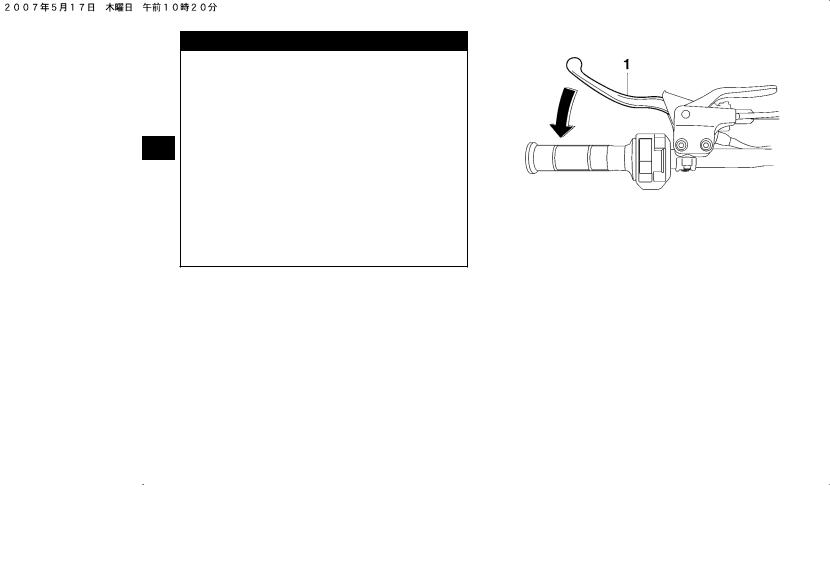
EWB00190
 WARNING
WARNING
POTENTIAL HAZARD
Improper adjustment of the speed limiter and throttle.
WHAT CAN HAPPEN
The throttle cable could be damaged. Im-
4
proper throttle operation could result. You could lose control, have an accident or be injured.
HOW TO AVOID THE HAZARD
Do not turn the adjusting screw out more than 12 mm (0.47 in). Always make sure the throttle lever free play is adjusted to 2.0–4.0 mm (0.08–0.16 in). (See page 8-22.)
EBU18382
Clutch lever
The clutch lever is located on the left handlebar and the ignition circuit cut-off system is incorporated in the clutch lever holder. To disengage the clutch, pull the clutch lever toward the handlebar grip. To engage the clutch, release the clutch lever. The clutch lever should be pulled rapidly and released slowly for smooth clutch operation. (See page 6-1 for a description of the ignition circuit cut-
off system.)
1. Clutch lever
EBU18411
Brake lever
The brake lever is located at the right handlebar grip. To apply the front brake, pull the brake lever toward the handlebar grip.
4-5
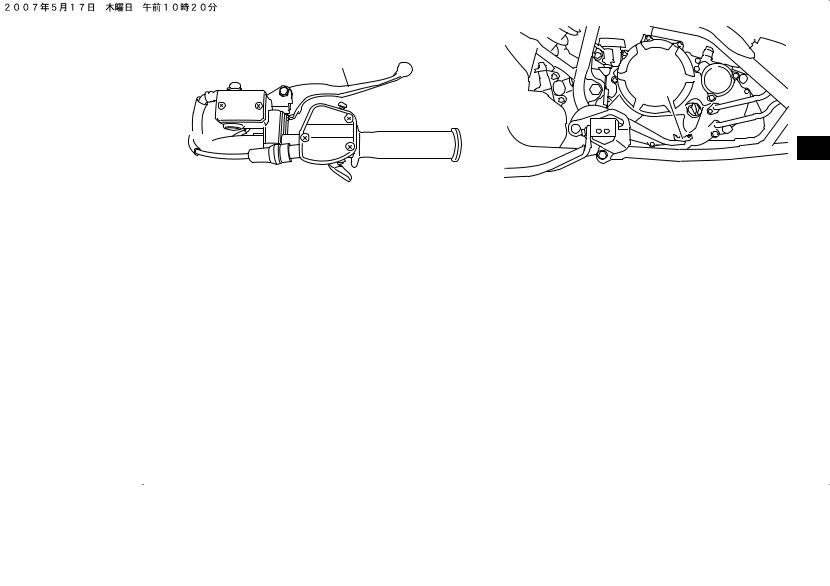
1
1
1. Brake lever
EBU18432
Brake pedal
The brake pedal is located on the right side of the ATV. To apply the rear brake, push down on the brake pedal.
4
1. Brake pedal
EBU18510
Parking brake lever
Use the parking brake before starting the engine or parking the ATV, especially on a slope. To apply the parking brake, move the parking brake lever in direction (a). To release the parking brake, move the parking brake lever in direction (b).
4-6
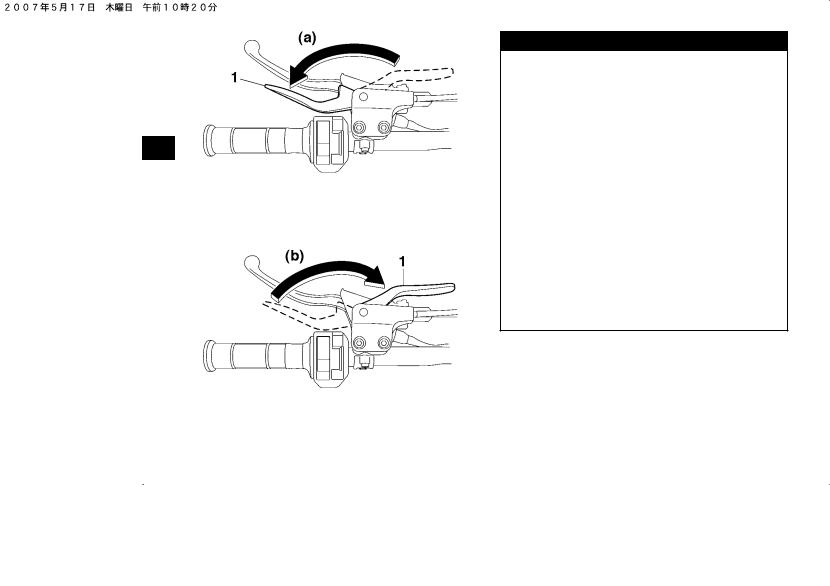
4
1. Parking brake lever (locked position)
1. Parking brake lever (unlocked position)
EWB00170
 WARNING
WARNING
POTENTIAL HAZARD
Improper use of the parking brake. WHAT CAN HAPPEN
The ATV could start moving unexpectedly if the parking brake is not applied before starting the engine. This could cause loss of control or a collision.
The brake could overheat if you ride the ATV without releasing the parking brake. You could lose braking performance which could cause an accident. You could also wear out the brakes prematurely.
HOW TO AVOID THE HAZARD
Always set the parking brake before starting the engine.
Always be sure you have released the parking brake before you begin to ride.
EBU18530
Shift pedal
This ATV is equipped with a constant-mesh 5- speed transmission. The shift pedal is located on the left side of the engine and is used in combination with the clutch when shifting.
4-7
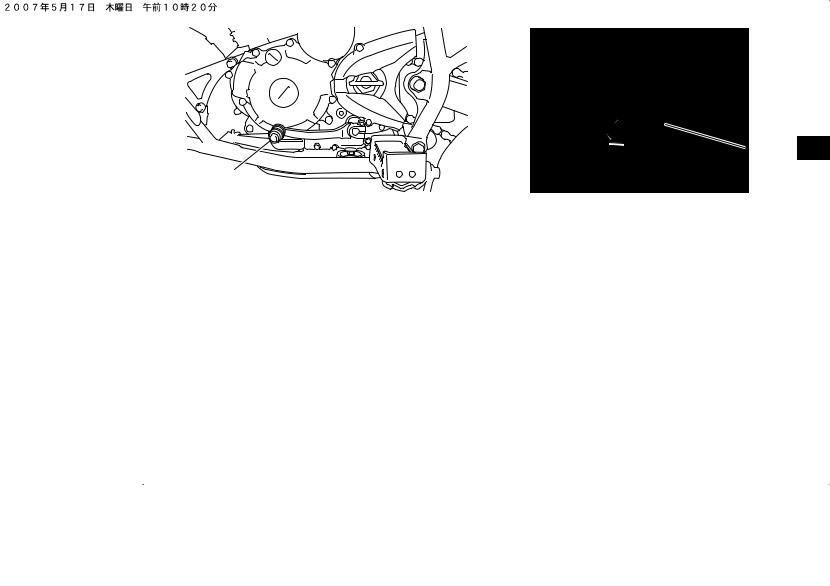
1
1. Shift pedal
EBU18720
Fuel tank cap
Remove the fuel tank cap by turning it counterclockwise.
4-8
1 4
1. Fuel tank cap
EBU18730
Fuel
Make sure that there is sufficient fuel in the tank. Fill the fuel tank to the bottom of the filler tube as shown.
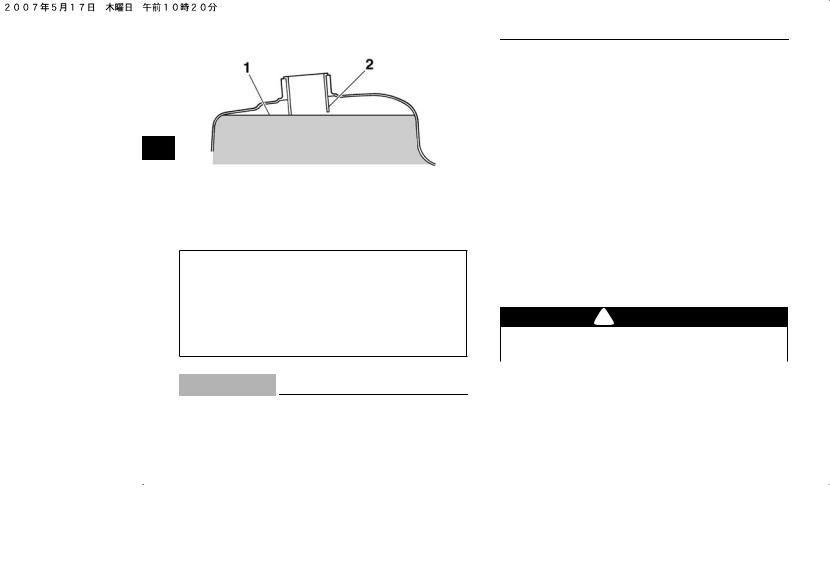
4
1.Fuel level
2.Filler tube
Recommended fuel:
UNLEADED GASOLINE ONLY Fuel tank capacity:
9.0 L (2.38 US gal) (1.98 Imp.gal) Fuel reserve amount:
1.0 L (0.26 US gal) (0.22 Imp.gal)
ECB00070
CAUTION:
Use only unleaded gasoline. The use of leaded gasoline will cause severe damage to internal engine parts, such as the valves and piston
rings, as well as to the exhaust system.
Your Yamaha engine has been designed to use regular unleaded gasoline with a pump octane number [(R+M)/2] of 86 or higher, or a research octane number of 91 or higher. If knocking or pinging occurs, use a different brand of gasoline or premium unleaded fuel. Unleaded fuel will give you longer spark plug life and reduced maintenance cost.
Gasohol
There are two types of gasohol: gasohol containing ethanol and that containing methanol. Gasohol containing ethanol can be used if the ethanol content does not exceed 10%. Gasohol containing methanol is not recommended by Yamaha because it can cause damage to the fuel system or ATV performance problems.
EWB00270
 WARNING
WARNING
POTENTIAL HAZARD
Improper care when refueling.
4-9
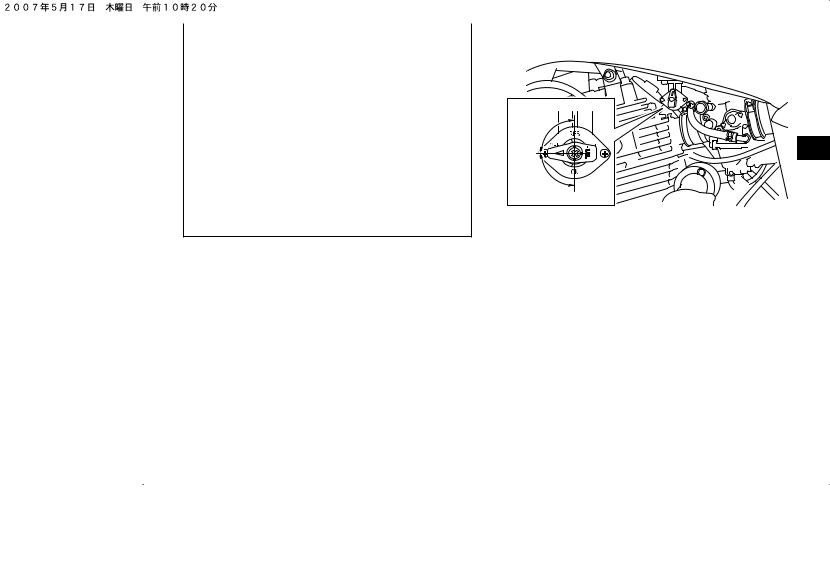
WHAT CAN HAPPEN
Fuel can spill, which can cause a fire and severe injury.
Fuel expands when it heats up. If the fuel tank is overfilled, fuel could spill out due to heat from the engine or the sun.
HOW TO AVOID THE HAZARD
Do not overfill the fuel tank. Be careful not to spill fuel, especially on the engine or exhaust pipe. Wipe up any spilled fuel immediately. Be sure the fuel tank cap is closed securely. Do not refuel right after the engine has been running and is still very hot.
EBU18820
Fuel cock
The fuel cock supplies fuel from the tank to the carburetor while also filtering it.
The fuel cock lever positions are explained as follows and shown in the illustrations.
OFF
OFF |
4 |
|
1. Arrow mark positioned over “OFF”
With the fuel cock lever in this position, fuel will not flow. Always turn the fuel cock lever to this position when the engine is not running.
4-10
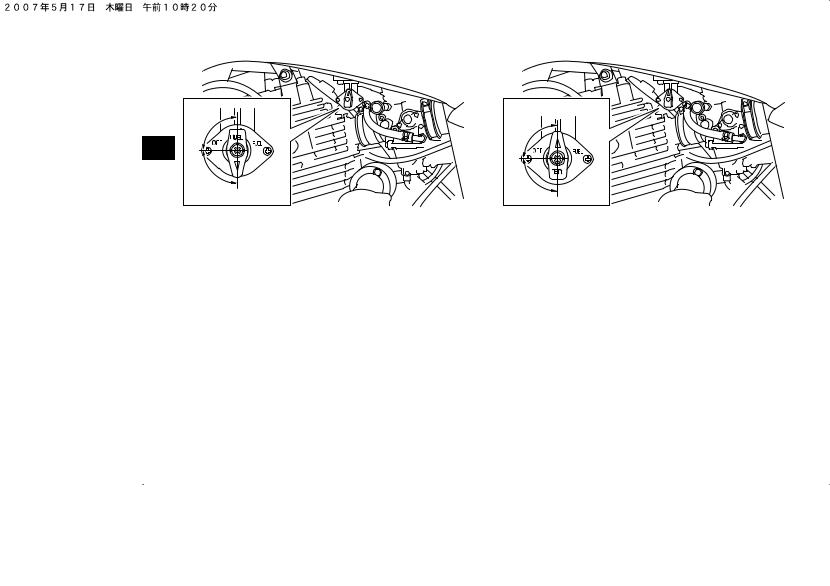
ON
4
ON
1. Arrow mark positioned over “ON”
With the fuel cock lever in this position, fuel flows to the carburetor. Turn the fuel cock lever to this position when starting the engine and riding.
RES
RES
1. Arrow mark positioned over “RES”
This indicates reserve. With the fuel cock lever in this position, the fuel reserve is made available. Turn the fuel cock lever to this position if you run out of fuel while riding. When this occurs, refuel as soon as possible and be sure to turn the fuel cock lever back to “ON”!
EBU18840
Starter (choke)
Starting a cold engine requires a richer air-fuel mixture, which is supplied by the starter (choke). Move the starter (choke) in direction (a) to turn on
4-11
